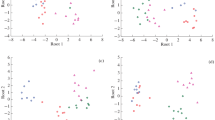Summary
Kainic acid, a cyclic analog of glutamate, has been reported by other investigators to reduce the number of serotonin (5HT) binding sites in rat striatum following an intrastriatal injection. We found that kainic acid injected into the striatum caused a dose-dependent increase in ipsilateral striatal 5-hydroxyindoleacetic acid (5HIAA) content, while not affecting the level of 5HT. There was no detectable change in 5HT metabolism in the contralateral striatum. The increase of 5HIAA was a reflection of increased 5HT turnover in the injected striatum as measured from the decline of 5HIAA after pargyline treatment or the rise of 5-hydroxytryptophan after benserazide treatment. There was also a concomitant increase of tryptophan hydroxylase activity. Kainic acid treatment resulted in an apparent decrease of the K mand increase of the V max for the pteridine cofactor and an increase of the V max for tryptophan by tryptophan hydroxylase. Kainic acid injection into the dorsal raphe nucleus caused a dose-dependent decrease in 5HT content of the dorsal raphe nucleus and in both striata, which are dorsal raphe nucleus projection areas. Our results suggest that 5HT formation in the striatum is normally modulated by an inhibitory neuronal feedback loop. Interruption of the loop by injecting kainic acid causes 5HT formation and tryptophan hydroxylase activity to increase in the ipsilateral but not contralateral striatum. Kainic acid apparently destroys 5HT neurons when injected close to the cell soma.
Similar content being viewed by others
References
Bobillier, P., Petitjean, F., Salvert, D., Ligier, M., Seguin, S.: Differential projections of the nucleus raphe dorsalis and nucleus raphe centralis as revealed by autoradiography. Brain Res. 85, 205–210 (1975)
Carlsson, A., Davis, J. N., Lindqvist, M., Kehr, W., Atack, C. V.: Simultaneous measurement of tyrosine and tryptophan hydroxylase activities in brain in vivo using an inhibitor of the aromatic amino acid decarboxylase. Naunyn-Schmiedeberg's Arch. Pharmacol. 275, 153–168 (1972)
Costa, E., Meek, J. L.: Regulation of biosynthesis of catecholamines and serotonin in the CNS. Ann. Rev. Pharmacol. 14, 491–511 (1974)
Coyle, J. T., Schwarcz, R.: Lesion of striatal neurons with kainic acid provides a model for Huntington's chorea. Nature 263, 244–246 (1976)
Fuller, R. W., Wang, D. T.: Inhibition of serotonin reuptake. Fed. Proc. 36, 2154–2158 (1977)
Gal, E. M., Patterson, K.: Rapid non-isotopic assay of tryptophan-5-hydroxylase activity in tissues. Anal. Biochem. 52, 625–629 (1973)
Geyer, M. A., Puerto, A., Dawsey, W. J., Knapp, S., Bullard, W. P., Mandell, A. J.: Histologic and enzymatic studies of the mesolimbic and mesostriatal serotonergic pathways. Brain Res. 106, 241–256 (1976)
Haigler, H. J., Aghajanian, G. K.: Serotonin receptors in the brain. Fed. Proc. 36, 2159–2164 (1977)
Hamon, M., Bourgoin, S., Herey, F., Simonnet, G.: Activation of tryptophan hydroxylase by adenosine triphosphate, magnesium and calcium. Mol. Pharmacol. 14, 99–110 (1978)
König, J. F. R., Klippel, R. A.: The rat brain. 4th edn. Baltimore: The Williams and Wilkins Co. 1963
Lowry, O. H., Rosebrough, N. J., Farr, A. L., Randall, R. J.: Protein measurement with the Folin phenol reagent. J. Biol. Chem. 193, 265–275 (1951)
McGeer, E. G., McGeer, P. L.: Duplication of biochemical changes of Huntington's chorea by intrastriatal injections of glutamic and kainic acids. Nature 263, 517–519 (1976)
Meek, J. L., Neckers, L. M.: Measurement of tryptophan hydroxylase in single brain nuclei by high pressure liquid chromatography. Brain Res. 91, 336–340 (1975)
Meek, J. L., Werdinius, S. B.: Hydroxytryptamine turnover decreased by the antidepressant drug chlorimipramine. J. Pharm. Pharmacol. 22, 141–143 (1970)
Merlis, J. K.: The effect of changes in calcium content of the cerebrospinal fluid on spinal reflex activity in the dog. Am. J. Physiol. 131, 67–72 (1940)
Neckers, L. M., Meek, J. L.: Measurement of 5HT turnover rate in discrete nuclei of rat brain. Life Sci. 19, 1579–1584 (1976)
Neff, N. H., Tozer, T. N., Brodie, B. B.: Application of steady-state kinetics to studies of the transfer of 5-hydroxyindoleacetic acid from brain to plasma. J. Pharmacol. Exp. Ther. 158, 214–218 (1967)
Olney, J. W., Rhee, V., Ho, O. L.: Kainic acid: A powerful neurotoxic analogue of glutamate. Brain Res. 77, 507–512 (1974)
Perry, K. W., Fuller, R. W.: Effect of 3-(p-trifluoromethylphenoxy)-N-methyl-3-phenylpropylamine hydrochloride (Lilly 110140), a specific inhibitor of serotonin uptake, on 5-hydroxyindole levels and turnover in rats. Fed. Proc. 33, 560 (1974)
Schwarcz, R., Bennett, J. P., Coyle, J. T.: Loss of striatal serotonin synaptic receptor binding induced by kainic acid lesions: Correlations with Huntington's disease. J. Neurochem. 28, 867–869 (1977)
Weiner, N., Lee, F.-L., Dreyer, E., Barnes, E.: The activation of tyrosine hydroxylase in noradrenergic neurons during acute nerve stimulation. Life Sci. 22, 1197–1216 (1978)
Zivkovic, B., Guidotti, A., Costa, E.: Effects of neuroleptics on striatal tyrosine hydroxylase: Changes in affinity for the pteridine cofactor. Mol. Pharmacol. 10, 727–735 (1974)
Author information
Authors and Affiliations
Rights and permissions
About this article
Cite this article
Neckers, L.M., Neff, N.H. & Wyatt, R.J. Increased serotonin turnover in corpus striatum following an injection of kainic acid: Evidence for neuronal feedback regulation of synthesis. Naunyn-Schmiedeberg's Arch. Pharmacol. 306, 173–177 (1979). https://doi.org/10.1007/BF00498988
Received:
Accepted:
Issue Date:
DOI: https://doi.org/10.1007/BF00498988




